As birdwatchers, we know that watching birds in nature around us can be a great source of joy, instill peace and calm into our daily lives, and teach valuable skills of patience and observation. By conducting a bird walk you get the opportunity to share your passion and knowledge with others, and get them to experience first hand the joy of birding. Introducing children to this hobby through a bird walk can be satisfying and challenging at the same time! How do you communicate the wonder of nature and hold their attention, while trying to make them think and also form an emotional bond with the birds? In this write-up, the Early Bird team shares the basics of conducting a bird walk for a group of beginners, which will hopefully provide some answers to these questions.
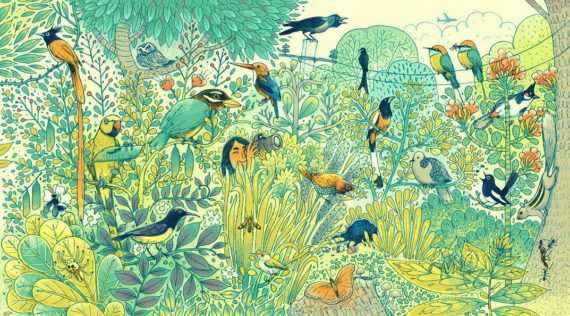
Illustration by Rajiv Eipe
Two broad types of situations may arise – one is where a school or nature club asks you to conduct a bird walk for their students, and the other may be a bird walk that you chose to conduct at a public location (like a neighbourhood park or lake) on a specific date or occasion (eg. to commemorate Salim Ali’s birthday, or celebrate a global birding event like the Great Backyard Bird Count, or as part of a celebration or festival at that public location). In the first case, you will have more accurate information about the participants (their numbers, ages and so on), while the second situation can be more unpredictable. For a public bird walk the audience will usually be a mix of adults and children, and children will usually be accompanied by a parent/adult. The suggestions below, however, are applicable to any bird walk for beginners (child or adult).
Venue
The choice of venue for the bird walk may be something that is pre-decided for you (e.g. if a school wants you to conduct a bird/nature walk on their school premises, or at a specific park/lake close to their school) or it may be a choice that is left to you (e.g. if you are conducting a public bird walk).
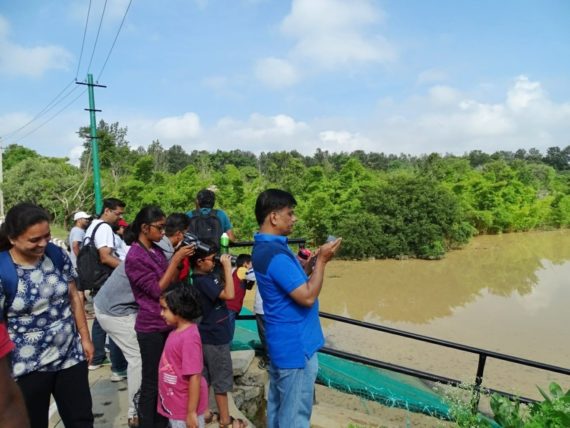
Photograph by Geetanjali
If the choice is left to you, it is important that you choose the venue keeping the audience in mind. For beginner birders, it is best to introduce them to birding at a lake rather than a forest, since wetland birds (like egrets, herons, ducks, storks, etc) are generally larger in size, less mobile and easier to spot than woodland birds. Experienced birders know that birding is an unpredictable hobby – a wooded patch may yield fantastic birding on one morning, and on another day may be very disappointing! But to a beginner, it is important that they see birds well, and if there are good numbers of birds then it generates some excitement (eg. hundreds of wintering ducks, or a group of Painted Storks flying overhead, or Pelicans fishing in a lake). A walk in a wooded area may be disappointing for a beginner, as they might hear a lot of birds, but be unable to see much.
If you know that the group has been birding before several times and have already been to water bodies for birding, then you could introduce them to forest birding depending on the age group and their interest. If the venue of the bird walk is pre-decided for you, you can plan the logistics and activities after visiting the venue and getting an idea of the age group of the participants (see subsequent sections).
Timing
Birds are most active around dawn and dusk. However, for beginners, getting up very early may be a difficult proposition and may act as an entry barrier for them to take up this hobby. For a school, logistics might also be difficult for a very early walk (organizing pickup of the students, getting teachers/parents to show up early, etc). In such cases, it may be fine to start the walk a bit “late” (say 8 am instead of 6 am), especially if you are conducting it at a water body since water birds will still be around and active/visible. At a lake, you could even conduct an evening bird walk, which would end before sunset. However, if the selected venue is a wooded area, keep in mind that you may not see or hear many birds once the sun is out, so an early start will be more important here.
Preparation (for you)
Visit the venue a few days or week before the walk, to get an idea of the birdlife there and familiarize yourself with the habitat and species expected to be seen. This is especially important if you have not birded at that location before, and will also give you an idea of the time it will take to cover that location for birding. Even if you are a veteran birder with years of experience, a recce of the birding location certainly helps!
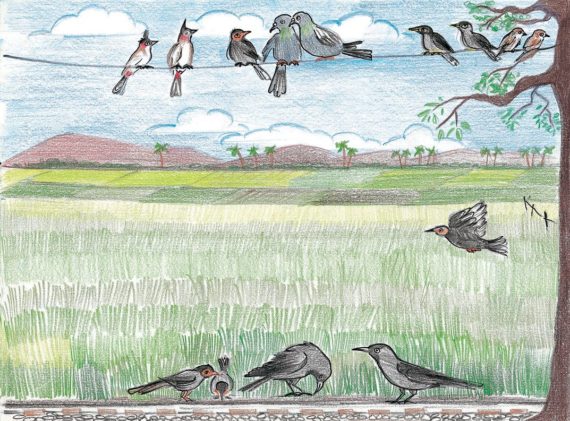
Illustration by Muniza Shariq and Preeti Krishnamurthy
Things to keep in mind:
- Is there a well-marked trail at the venue? How long is the trail? Is it paved or a mud track? Will young children/seniors find it difficult?
- Make a mental note of different habitats around so you can guide the participants accordingly (eg. an urban lake may have buildings on one side, a wooded patch on another other, and a marshy area at the back, which are different habitats with different species that you can point out).
- Is there a particular spot from where birds are more easily seen? This could be a spot with a view of nesting colonies of storks/herons/cormorants, a fruiting tree, roosting trees where flocks of mynas/starlings congregate, or simply a place from where bird-rich areas of the lake are clearly seen.
- Is there a spot where children could be asked to sit and various activities conducted? For children who are first-time birders (particularly young children), it may be difficult to hold their attention for long, so some group activities/games (refer to the resources available on the Early Bird website) coupled with a short bird walk may be more effective.
- Make a list of 10 or 20 common birds that you expect to see/hear during the walk. Familiarize yourself with their calls, their food, behavior and migratory status. You could use the Early Bird flashcards for this or refer to the internet. In the absence of flashcards, you could choose to take print-outs of good quality photos of these species that you can find from the internet, which can be passed around for participants to appreciate the birds better.
Age and group size
If it is possible to get this information in advance (e.g. if you are asked to conduct a bird walk for a school), find out what age group of children will be attending the bird walk. In general, it may not be advisable to take children below the age of 6 or 7 on a bird outing, and indoor games may be a better option for this age group. Alternatively, you can consider a brief bird walk to see large birds that can be easily spotted, followed by an activities session in which you make them sit in a group at one location and conduct various activities. Children 8 years and above will have the necessary attention span and cognitive skills to appreciate a bird walk.
It is a good practice to have one or more facilitators for every 5 children. If the group size is large, try to rope in your birding friends or find some volunteers to help you out. If the bird walk is being conducted for a school, their teachers would likely be there too (or you can specify that teachers need to be present), and while you can get their help in controlling the children and keeping the group together, they may not be able to offer much help in identifying birds or conducting the walk. If it is a public bird walk you are conducting, try and get people to register in advance so you can get an idea of the attendance, and plan volunteer support accordingly.
Material
Below is a list of materials – printed materials as well as optical equipment, that can be useful especially for conducting a bird walk with beginners, who are unlikely to have any of their own materials.
- Optical equipment: There is nothing quite like seeing a bird up close! Binoculars are a must, and you can ask the facilitators to bring any extra binoculars they might have. A spotting scope, if available, can be a huge attractor for beginner birders, especially at a water body where you can station it at a good location so that passers-by can also take a look. If you are in a big city which has stores that sell binoculars (or a branch of a company that makes binoculars, like Zeiss), try contacting them to find out if they are willing to send 5-6 pairs of binoculars or a spotting scope to be passed around during the walk. It’s free publicity for them, and often they are happy to be associated with local birdwatcher’s groups.
- Field guides/identification aids: For beginner birders, you can pass around a few of the appropriate Early Bird pocket guides, which list the common birds of the region and are handy to carry around. Early Bird flashcards can also be used as identification aids during the walk, or photos of birds that you have printed out. Keep a more comprehensive field guide with you as a back-up.
- Activities: If the group is anticipated to be large or consisting of young children, it may be a good idea to carry print-outs of games (like Bird bingo) or art activities (refer to the resources available on the Early Bird website).
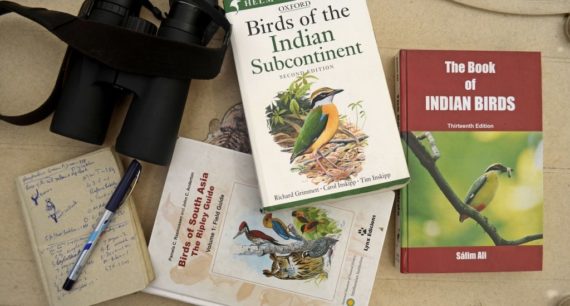
Photograph by P Jeganathan
Preparation (for the participants)
As the facilitator, it is recommended that you inform the participants (or the school administrators who have organized your walk) a few days in advance, about what to expect on the walk. Information provided should include the start time, expected duration of the walk, the meeting point, what they should carry (water bottle, notebook-pencil, binoculars, insect repellant) and what to wear (comfortable shoes, dull coloured clothing, cap, rain gear in case of rain). If the walk is scheduled in the morning, it is a good idea to ask participants to carry some snacks or bananas with them, especially if there are children accompanying them. Alternatively, inform the school authorities to provide packed breakfast for the children. A hungry child will not be interested in seeing birds!
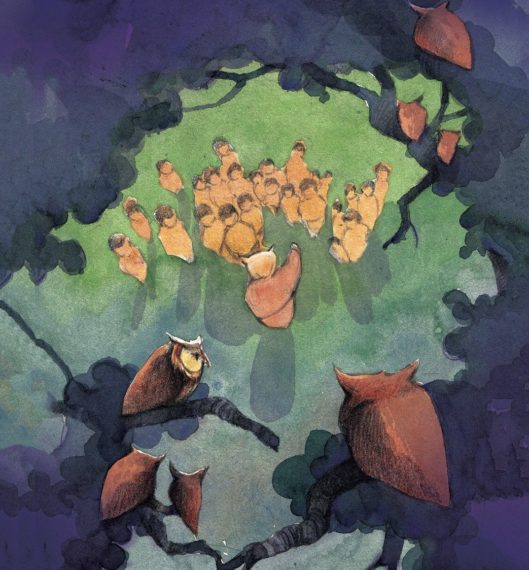
Illustration by Ariful Islam
Tips and tricks
- Before the walk: Before starting the bird walk, give a brief (< 5 min or so) introduction about birdwatching (eg. what is fascinating about birds, why we watch birds, how many species of birds there are in India/your state, info on migration) and a brief introduction to the location (eg. is it a lake maintained by neighbourhood residents, etc). If at a public walk, ask the participants if they have any experience of birding, and perhaps to name one favourite bird if they have been birding before.
- During the walk: For beginners, and especially for children, simply pointing out a bird and mentioning its name or some identification features may not be enough to hold their attention. Providing interesting information on commonly seen species is a good way of keeping them engaged, especially if there is a lull in the walk (nothing in sight, or no new birds seen). For example, Magpie-Robins have a varied song and are known to mimic other birds; Grebes have webbed feet and spend their entire life in water (they are unable to walk on land), Pigeons and Doves can drink water by using their beak like a straw, unlike other birds which have to tilt their head back to swallow. You could also make things interesting by asking quiz questions (eg. which neighbouring country of India has Magpie-Robin as its national bird?) or telling a bird story or playing a game.
- Identification: If the participants are first-time birdwatchers, and especially if they are children, don’t worry about the full name of the species (eg. just Magpie-Robin is sufficient, rather than Oriental Magpie-Robin) as it may intimidate or confuse them. Use your discretion in this, for example, you may need to differentiate Grey Heron from Purple Heron. However, warblers and sandpipers/waders are difficult for beginners to identify, so you may want to leave the ID as just “sandpiper” or “warbler” as appropriate. For migratory birds, do mention how far they may have traveled as that is one of the wonders of the avian world. If the participants are very young children, an interesting game to play would be to ask them to use their imagination and name the birds they see during the walk! Illustration by Sangeeta Kadur
- Watching birds and their behaviour: Try to look for birds that are doing something interesting, eg, a Pond-Heron stalking a fish, or a Coot being protective of its chicks, or a juvenile begging from its parent. Ask participants to observe birds beaks and try to correlate them with their food (eg. sunbirds have long, pointed beaks to sip nectar). If time and opportunity occur, the children could sit at a quiet spot to observe and draw some birds in their notebook.
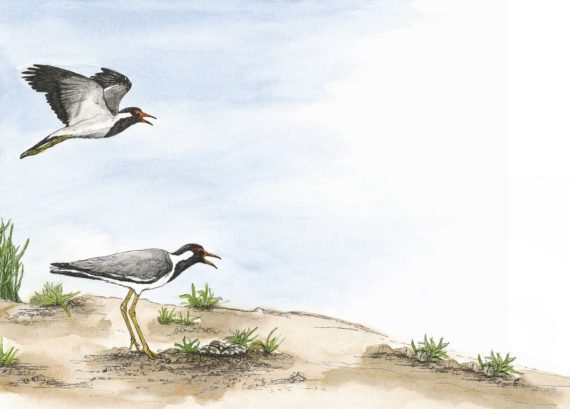
Illustration by Sangeeta Kadur
- Guiding older children: If you get a child or group of children who have been birding before and seem to rattle off names of birds (correctly or otherwise), or demand that you promptly identify each species, try and get them to learn on their own rather than providing the information directly. Ask them to observe the bird in question, its physical characteristics (is the neck long or short, is the beak small or pointed or thick, are the legs long), its behavior (is it feeding on nectar or berries or seeds or fish) and try and get them to find it themselves in the pocket guide.
- Answering questions: Don’t be afraid to say that you don’t know! In fact, even if you do know the answers, it may be more effective to say “let’s try and find out” especially if the question is related to something that can be observed during the walk.
- Group size: In case you get a larger-than-expected turnout for the bird walk, consider splitting the groups into 3 or 4 smaller groups, each with a facilitator (or two), and make them cover different portions of the venue (if the venue is large enough), or plan for different parallel activities (say 20 minutes each) that the groups could do by rotation. Eg. One group could watch birds, while another group plays bird bingo or flashcard games and a third group sits in one spot sketching/coloring or doing some creative nature activities.
Safety
This is an important aspect of doing any work with children. If you are doing a bird walk for a school, they have implicitly entrusted you with the responsibility of keeping the children safe for the duration of your walk. A subsequent chapter addresses this topic in more detail, but here are a few simple guidelines:
- Ensure that the children in your group remain within your view at all times.
- Make them into groups of twos or threes (ideally threes) and instruct them to be with each other at all times.
- Have a basic first aid kit available with one of the volunteers, or ask the school to ensure that one of the teachers carries this.
- Have a child: adult ratio of 5:1 or lower (includes teachers/helpers/facilitators).
- Instruct the children (if older children) that no inappropriate speech is allowed.
- If taking photos of children during the walk, it is a good idea to ask for permission from the parent/school. Also, a good practice to always take group photos rather than a photo of a single child. Ask permission if planning to post photos publicly, e.g. on social media.
- Do not pass on your number to children, or take their phone numbers (if they are old enough to have phones). This is for your safety as well as theirs. However, this should not stop you from mentoring a particularly interested or talented child, just make sure the contact is made through the parent or the school.
- Make sure the other volunteers you have engaged for helping out are known to you and reliable and instruct them on the rules above.
Follow up
A one-off session with children, even though enjoyable, might not lead to sustained interest or awareness. The importance of follow-up cannot be overemphasized! If you have conducted a bird walk for a school, try and follow up with them a few days or weeks after the walk, to see if they have noticed any interesting birds in their campus or elsewhere. You could also suggest some follow-up activities to them that they can carry out on their school premises. Here are some suggestions:
- maintaining a daily or weekly bird “attendance register”
- collecting clippings of birds in the news and discussing it weekly/monthly
- organizing an annual bird “festival”
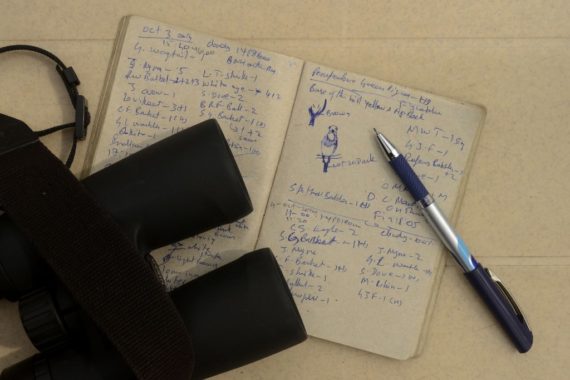
Photograph by P Jeganathan
When possible, repeat bird walks with the same group of participants are likely to spark interest among at least a few of them who may get hooked to watching birds. They could then be pointed to other resources to develop their skills (such as regular bird walks conducted by other local groups, books, web resources). And if appropriate (adults or older children), could participate in citizen science by recording/documenting their observations (refer the resources available at www.birdcount.in).

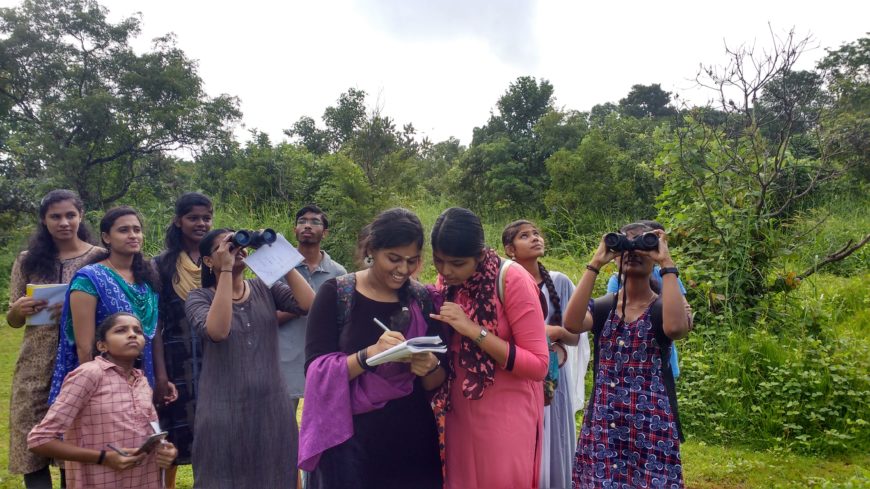
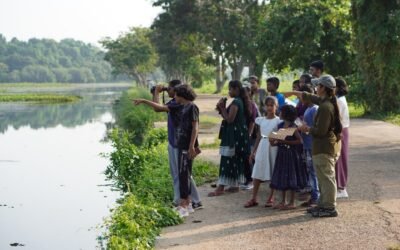
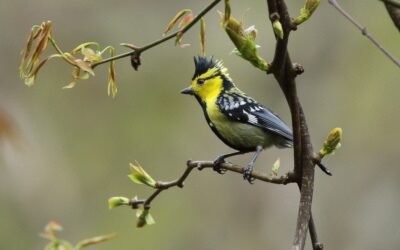
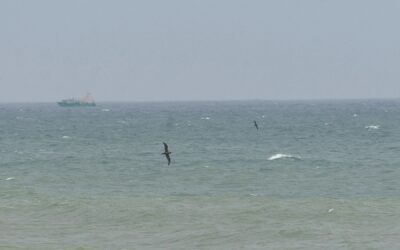
Thanks , I was looking forward to an article as this . However in an urban forested estate what could be a clever method to design a trail ?What about animal hazards lurking while on such trails ? Which is an ideal location for child to sketch ? And how much time should we permit them . How far should be the first aid in case of a reptile bite ? How to dissuade people from detaching without a warning into their picnic orientation ? How to stop children rushing behind attractive birds as common as peahens. Guide us on these as well .